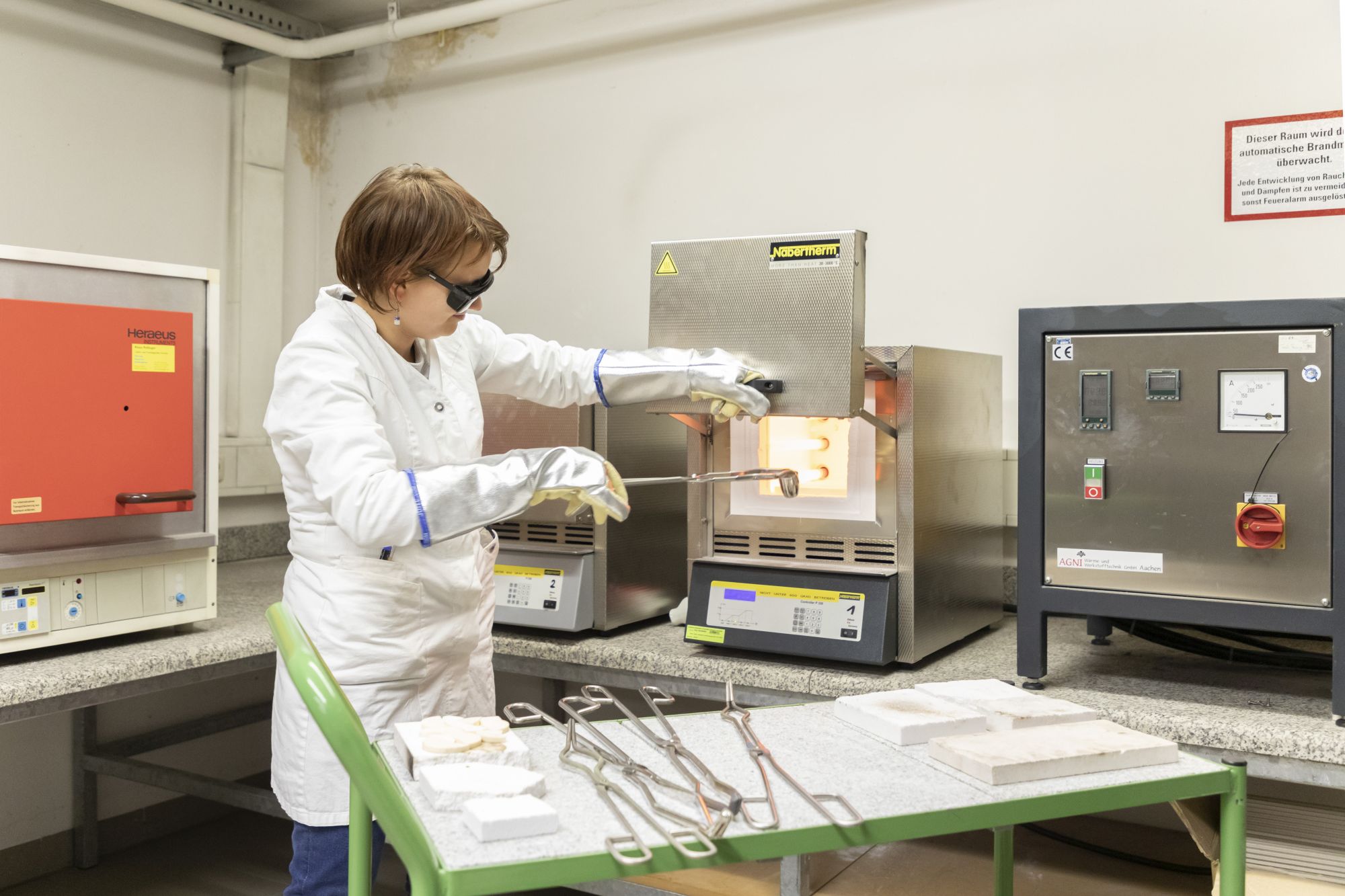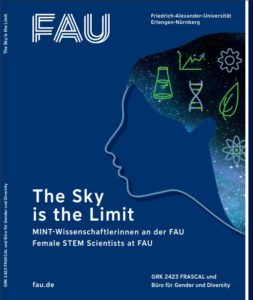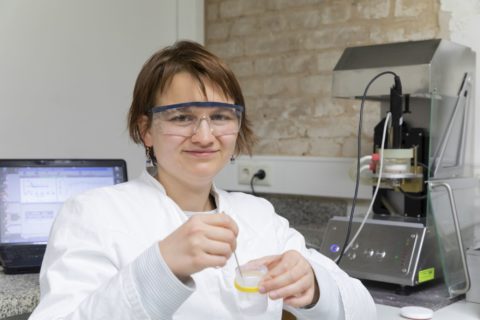What mineralogy and dentures have in common
In our series of 22 reports, we present a panorama of female researchers from various qualification levels and academic positions, ranging from students to W3 professors. With their individual career paths, the female researchers in STEM subjects act as role models to encourage young female researchers to pursue an academic career, giving interesting insights into their careers to date. The MINT experts also share aspects of their private lives.
Katrin Hurle, postdoctoral researcher: What mineralogy and dentures have in common
Mineralogist Dr. rer. nat. Katrin Hurle, who was born in 1985, comes from a small village near Donauwörth and is the first member of her family to go to university. She was fascinated by minerals even as a child, which is one of the reasons she started a degree in mineralogy (a geoscientific discipline) at FAU in 2005. Today, she works with minerals in medical engineering that are used to benefit patients. Hurle is now a postdoctoral researcher at GeoZentrum Nordbayern where she also teaches and is preparing for her postdoctoral thesis. She has published her research and has received a considerable amount of third party funding. She is also actively involved in several committees at FAU.
Have there been any key moments in your life that have convinced you that you’re on the right track?
Yes, I knew that mineralogy was the right thing for me as soon as I started studying, as it is such a varied subject. During my diploma thesis, I carried out some experiments about the Y2O3 – Al2O3 – B2O3 phase system, which is important for synthesising laser crystals. During this time, I was able to go on my first field trip to visit some crystal growers in Idar-Oberstein. The fact that my first publication was accepted by a journal during my doctoral degree also gave me a lot of encouragement. It’s a great feeling to discover your own name among all the others in a literature database. Another important motivation was a message from a professor at the University of Würzburg shortly afterwards that said he had read my publication and wanted to work with me. We are still working together. And of course, it was great to finally be able to hold my doctoral degree certificate in my hands. It certainly encouraged me to continue my scientific career.
Why did you decide to stay at FAU after completing your degree?
While writing my diploma thesis, I realised I wanted to work on scientific projects in more depth. I gladly accepted the offer from my Chair to complete a doctoral degree in mineralogy there, especially as after the laser materials, another new and exciting topic was calling – calcium phosphate cements for medical applications as bone substitutes. This topic has enabled me to collaborate with a research institute in Switzerland. My doctoral degree was financed to a large extent by a scholarship awarded by the Evangelisches Studienwerk Villigst. I continued my research in a year long postdoctoral scholarship from FAU for the promotion of equal opportunities for women in research and teaching. I used this time to apply for funding for a project from the German Research Foundation (DFG), which I was awarded and has secured my position and my research activities for a further three years. This project involves working closely with the Department of Functional Materials in Medicine and Dentistry at the University of Würzburg. During this time I was awarded the Faculty Women’s Prize at the Faculty of Sciences at FAU for successful young female researchers. I used the prize money to employ a female doctoral candidate for my team who I really enjoy working with. I am currently working on another DFG project that involves conducting detailed investigations into lithium silicates, which are used to make dental prostheses.
You could also work in industry with your doctoral degree in natural sciences.
Yes, but I have made a conscious decision to pursue an academic career as I really enjoy teaching as well as research and I really like passing on my knowledge to students, whether it’s during lectures and seminars or when supervising final theses. You don’t get that if you work at a company. In addition, there’s much less pressure at a university to quickly produce results that make a profit. You can dig deeper into scientific topics than you can in industrial research, and you can carry out more fundamental research. I think this is extremely interesting.
What does your work involve?
I spend a lot of time on the computer in the office, but I also work in the lab where I use special measuring equipment such as X-ray diffractometers or heat flow calorimeters. I can usually delegate simple lab work to my student assistants – we make a great team. I then evaluate the results of my experiments on the PC. Ideally, they then lead to publications. I participate in scientific conferences once or twice a year and get some inspiration from the other scientists taking part. I had the opportunity to travel to Los Angeles and have twice spent several weeks at a research institute in Portugal.

What do you find so fulfilling about your STEM subject?
I especially enjoy having the opportunity to get to the bottom of a problem and finding out new things. I like working in a team and trying to produce new findings where all team members can contribute their expertise from different perspectives. The fact that FAU has such a wide variety of engineering and scientific departments means I can work on several different projects with other Chairs at the University, for example with the Chair of Glass and Ceramics at the Faculty of Engineering. Personally, I feel that my research is meaningful as I am working on medical products such as dental prosthetics or bone cement. My work could potentially lead to the development of improved materials that might benefit patients one day.
You’re also involved in various University committees.
Yes, for the last two years I have been the non-professorial teaching staff representative on the management board of GeoZentrum Nordbayern. During the monthly board meetings we discuss the contents of degree programmes, among other things, which is very interesting. The committee also always includes a Women’s representative, which means we regularly discuss projects for promoting equal opportunities for women. I am currently also a member of the board of the Department of Geography and Earth Sciences.
What can be done to attract more women to STEM subjects?
I think it’s extremely important to allow female school pupils to experience STEM subjects at first hand. Our Chair has been involved in the Girls’ Day and the Girls and Technology internship for several years now. During these events, we use hands-on experiments to show the girls that geosciences are both varied and fun. I believe this is a very effective way to attract new female students. We also make sure that most of the experiments are supervised by women during these events. In this way, the girls learn that geosciences are not just for boys and that women can also have successful careers in these subjects. Of course, we also try to provide targeted support to qualified female students at our Chair, by offering them doctoral positions, for example.
What advice would you give young female researchers who wish to pursue an academic career?
It’s always useful to talk to other women in a similar situation to yourself. It’s important to stay in touch with women you might meet at workshops or conferences who are in a similar stage of their careers. It’s also a good idea to use the networking opportunities at your own Chair and at the University. And another piece of advice I would give in case things aren’t going according to plan as I also suffered from a lack of motivation during certain phases of my doctoral degree and thought I wasn’t making any real progress. You shouldn’t be afraid of seeking professional counselling if this happens to you as some useful advice from someone from outside can make a huge difference.
This article is part of the brochure “The Sky is the Limit”

Brochure “The Sky is the Limit”
Diverse, inspiring and innovative, the brochure “The Sky is the Limit” introduces female researchers in STEM subjects from the Faculty of Engineering and the Faculty of Sciences in a series of varied interviews.
Other interviews are available on the Research website.
Download the brochure “The Sky is the Limit — Female STEM scientists at FAU”
The publication is the result of collaboration between RTG 2423 FRASCAL and the Office of Equality and Diversity. Dr. Susanne Stemmler conducted the interviews.
